AMD's Radeon HD 5870: Bringing About the Next Generation Of GPUs
by Ryan Smith on September 23, 2009 9:00 AM EST- Posted in
- GPUs
Cypress: What’s New
With our refresher out of the way, let’s discuss what’s new in Cypress.
Starting at the SPU level, AMD has added a number of new hardware instructions to the SPUs and sped up the execution of other instruction, both in order to improve performance and to meet the requirements of various APIs. Among these changes are that some dot products have been reduced to single-cycle computation when they were previously multi-cycle affairs. DirectX 11 required operations such as bit count, insert, and extract have also been added. Furthermore denormal numbers have received some much-needed attention, and can now be handled at full speed.
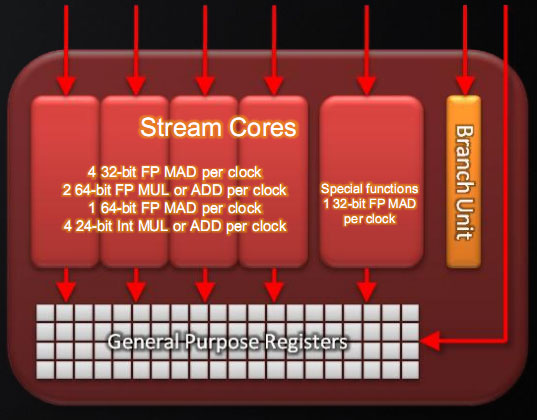
Perhaps the most interesting instruction added however is an instruction for Sum of Absolute Differences (SAD). SAD is an instruction of great importance in video encoding and computer vision due to its use in motion estimation, and on the RV770 the lack of a native instruction requires emulating it in no less than 12 instructions. By adding a native SAD instruction, the time to compute a SAD has been reduced to a single clock cycle, and AMD believes that it will result in a significant (>2x) speedup in video encoding.
The clincher however is that SAD not an instruction that’s part of either DirectX 11 or OpenCL, meaning DirectX programs can’t call for it, and from the perspective of OpenCL it’s an extension. However these APIs leave the hardware open to do what it wants to, so AMD’s compiler can still use the instruction, it just has to know where to use it. By identifying the aforementioned long version of a SAD in code it’s fed, the compiler can replace that code with the native SAD, offering the native SAD speedup to any program in spite of the fact that it can’t directly call the SAD. Cool, isn’t it?
Last, here is a breakdown of what a single Cypress SP can do in a single clock cycle:
- 4 32-bit FP MAD per clock
- 2 64-bit FP MUL or ADD per clock
- 1 64-bit FP MAD per clock
- 4 24-bit Int MUL or ADD per clock
- SFU : 1 32-bit FP MAD per clock
Moving up the hierarchy, the next thing we have is the SIMD. Beyond the improvements in the SPs, the L1 texture cache located here has seen an improvement in speed. It’s now capable of fetching texture data at a blistering 1TB/sec. The actual size of the L1 texture cache has stayed at 16KB. Meanwhile a separate L1 cache has been added to the SIMDs for computational work, this one measuring 8KB. Also improving the computational performance of the SIMDs is the doubling of the local data share attached to each SIMD, which is now 32KB.
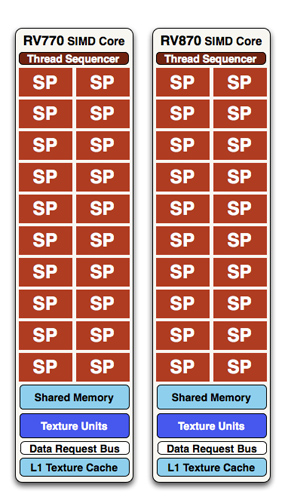
At a high level, the RV770 and Cypress SIMDs look very similar
The texture units located here have also been reworked. The first of these changes are that they can now read compressed AA color buffers, to better make use of the bandwidth they have. The second change to the texture units is to improve their interpolation speed by not doing interpolation. Interpolation has been moved to the SPs (this is part of DX11’s new Pull Model) which is much faster than having the texture unit do the job. The result is that a texture unit Cypress has a greater effective fillrate than one under RV770, and this will show up under synthetic tests in particular where the load-it and forget-it nature of the tests left RV770 interpolation bound. AMD’s specifications call for 68 billion bilinear filtered texels per second, a product of the improved texture units and the improved bandwidth to them.
Finally, if we move up another level, here is where we see the cause of the majority of Cypress’s performance advantage over RV770. AMD has doubled the number of SIMDs, moving from 10 to 20. This means twice the number of SPs and twice the number of texture units; in fact just about every statistic that has doubled between RV770 and Cypress is a result of doubling the SIMDs. It’s simple in concept, but as the SIMDs contain the most important units, it’s quite effective in boosting performance.
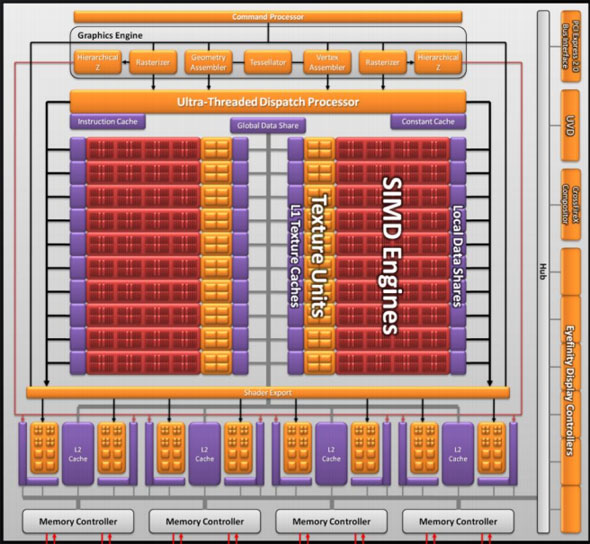
However with twice as many SIMDs, there comes a need to feed these additional SIMDs, and to do something with their products. To achieve this, the 4 L2 caches have been doubled from 64KB to 128KB. These large L2 caches can now feed data to L1 caches at 435GB/sec, up from 384GB/sec in RV770. Along with this the global data share has been quadrupled to 64KB.
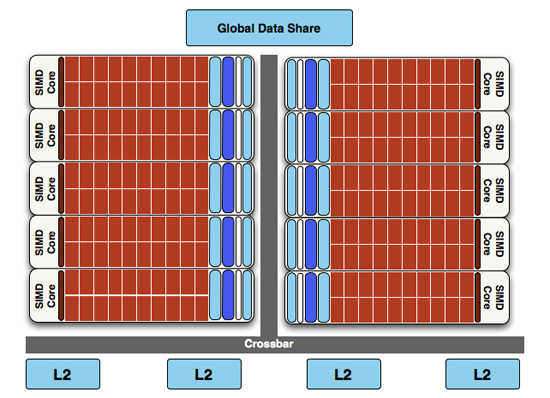
RV770 vs...
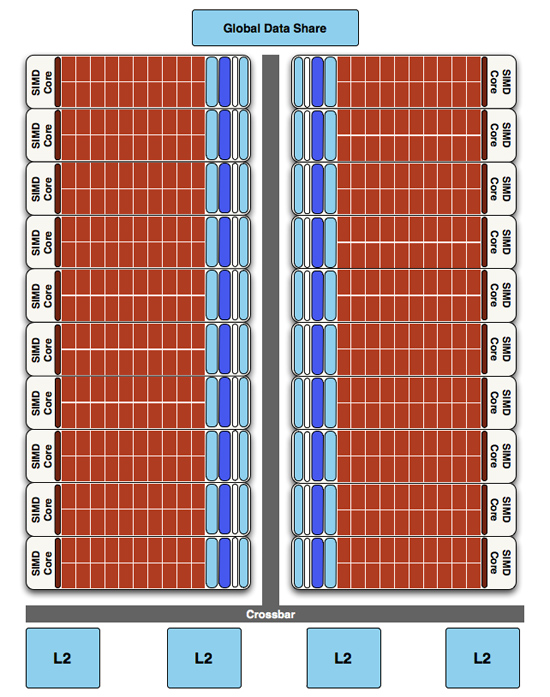
Cypress
Next up, the ROPs have been doubled in order to meet the needs of processing data from all of those SIMDs. This brings Cypress to 32 ROPs. The ROPs themselves have also been slightly enhanced to improve their performance; they can now perform fast color clears, as it turns out some games were doing this hundreds of times between frames. They are also responsible for handling some aspects of AMD’s re-introduced Supersampling Anti-Aliasing mode, which we will get to later.

Last, but certainly not least, we have the changes to what AMD calls the “graphics engine”, primarily to bring it into compliance with DX11. RV770’s greatly underutilized tessellator has been upgraded to full DX11 compliance, giving it Hull Shader and Domain Shader capabilities, along with using a newer algorithm to reduce tessellation artifacts. A second rasterizer has also been added, ostensibly to feed the beast that is the 20 SIMDs.










327 Comments
View All Comments
ilnot1 - Wednesday, September 23, 2009 - link
In fact, going by the lowest Newegg prices, this is how the top setups would stack up today:5870 CF .......= $760
GTX 285 SLI .= $592
GTX 295 .......= $470
GTX 275 SLI .= $420
5870 ............= $380
4890 CF ........= $360
4870 X2 ........= $330
This would make the 4890 CF or the 275 SLI setups the best value. And yes I realize there will be availability issues and price adjustments over the next month or so.
DominionSeraph - Thursday, September 24, 2009 - link
you forgot:4870 CF: $260-280
and how about the $180 4850 CF, which is probably the best price/performance for sub-1920x1200 gaming. http://www.anandtech.com/video/showdoc.aspx?i=3517...">http://www.anandtech.com/video/showdoc.aspx?i=3517... You can even get 1GB versions for ~$190.
ilnot1 - Wednesday, September 23, 2009 - link
Another very good review, thanks.But piggy backing on what wicko said, I'm surprised you didn't include two 4890 in CF. Seeing as how you can get two 4890 for less than a 5870 (whenever they are actually available). $180 x 2 = $360 < $379. And this from Newegg, not some super special sale price.
http://www.newegg.com/Product/Product.aspx?Item=N8...">http://www.newegg.com/Product/Product.aspx?Item=N8...
Ryan Smith - Wednesday, September 23, 2009 - link
It's something we would have included if we had the cards. I don't have 2 4890s, and we couldn't get a second one in time.AnotherGuy - Wednesday, September 23, 2009 - link
as always anandtech roxnbjsl2000 - Wednesday, September 23, 2009 - link
Finally time to upgrade..SiliconDoc - Wednesday, September 23, 2009 - link
Not only all that, but when there were 13 big titles for PhysX and a hundred smaller ones, we were told here, "Meh", who needs it.Now, we have a papery and unavailable (egg)except by pre-order(tiger) 5870 launch, a not-existing 5850, with guess what ? NO DX11 games!
Oh wait, there is actually just ONE - see page 7 of review. LOL
---
Conclusion ?: " It looks like NO(err.. just one) DX11 games ready, so... it also looks like NVidia is launching at the right time, and ATI blew their dry unimpressive wad on a piece of paper porn. "
---
Gee no one crowing about the first DX11 card... imagine that...
Good thing , too, considering how 13 big or a hundred titles small of PhysX enhanced games was "nothing to change one's purchase decision over". At least Anand got addicted to Mirror's Edge with PhysX enabled before concluding in the article "meh" this PhysX thing is ok if you like this game, but who cares...
---
Now we have the DX11 pre DX11 games launch with a paper product, so crowing about it wouldn't be too fitting, huh.
monomer - Wednesday, September 23, 2009 - link
Why would a developer would release a DX11 game before DX11 is even available?SiliconDoc - Friday, September 25, 2009 - link
Why would a developer release a DX11 card before DX11 is even available ?(I suppose you'll have to unscrew your hate nvidia foil cap, and grind in the red spikes in it's place to answer that one.)
However, allow me, instead.
1.I have been running windows 7 32&64 for quite some time now, not sure why you haven't been.
2. Battleforge, an ATI promo game, as noted in the review, has released their DX11 patch, hence, with W7 from MSFT (the beta+ free trial good till March 1st 2010 or something like that) I believe any gamer has had a reasonable chance to preview DX11.
---
So anyway...
cactusdog - Friday, September 25, 2009 - link
Ya , ATI has done it again. Excellent performance for a fair price. If Nvidia released this exact card it would be $150-$200 more expensive.LOL, Nvidia sales are gonna be slow for a while.